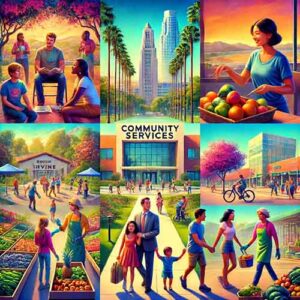Irvine - 1950-1999 Did You Know
Irvine's Post-World War II Boom
Irvine, California experienced remarkable changes from 1950 to 1999. The area transformed from agricultural lands into the well-planned urban oasis we see today. In the early 1950s, the land was dominated by fields of crops. The Irvine Ranch was known for its agricultural superiority. But it was clear changes was on the horizon.
Irvine City Takes Off
The 1960s were especially a period of widespread changes for Irvine. The establishment of the University of California, Irvine (UCI) in 1965 was a game-changer. Suddenly, this region became an education and research center, attracting talent from all over the globe. This fueled further development and planning. By 1971, Irvine officially became a city, marking its transition from ranch lands to a planned urban community.
Throughout the 70s, 80s, and 90s, Irvine’s growth was impressive. Thanks to the Irvine Master Plan, the city expanded in a way emphasizing green spaces, top-notch schools, and plenty of community amenities. By the end of the 20th century, Irvine had firmly established itself as a city known for its high quality of life, safety, and innovative spirit.

1950-1999 Did You Know...
1. 1950: The Irvine Ranch, covering over 93,000 acres, was owned by the Irvine Company.
2. 1951: Irvine Ranch expanded its agricultural operations, becoming a leading producer of oranges.
3. 1952: The Irvine Company began developing residential communities on the ranch.
4. 1953: Myford Irvine, a significant figure in the city’s development, passed away.
5. 1954: The first modern residential tract was developed in the Irvine Ranch.
6. 1955: Irvine Company introduced the concept of master-planned communities.
7. 1956: The University of California considered Irvine as a potential location for a new campus.
8. 1957: Plans for the Irvine Ranch Master Plan were publicly announced.
9. 1958: The Irvine Company hired architect William Pereira to design the master plan.
10. 1959: The Irvine Company officially presented the Irvine Ranch Master Plan.
11. 1960: The University of California announced the establishment of UC Irvine.
12. 1961: Construction began on the University of California, Irvine (UCI) campus.
13. 1962: The Irvine Ranch Master Plan was approved by the Orange County Board of Supervisors.
14. 1963: The first buildings of UCI were completed, including the Central Library and Humanities Hall.
15. 1964: The city of Irvine was officially incorporated.
16. 1965: UCI welcomed its first class of students.
17. 1966: The Irvine Company developed its first residential villages, Turtle Rock and University Park.
18. 1967: Irvine was recognized for its innovative approach to urban planning.
19. 1968: The Irvine Barclay Theatre opened, enhancing the city’s cultural offerings.
20. 1969: The first annual Irvine Street Fair and Chili Cook-Off was held.
21. 1970: The population of Irvine reached 10,000 residents.
22. 1971: The Irvine Spectrum Center’s initial phase opened as an office complex.
23. 1972: The city of Irvine introduced its first public parks and recreational facilities.
24. 1973: Irvine’s first community center was established in University Park.
25. 1974: The city launched its first public transportation system.
26. 1975: Irvine Meadows Amphitheatre opened, becoming a major concert venue.
27. 1976: The Irvine Civic Center was dedicated.
28. 1977: The city hosted its first annual Easter Egg Hunt at William R. Mason Regional Park.
29. 1978: Irvine received national recognition for its master-planned community design.
30. 1979: The first phase of the Irvine Industrial Complex was completed.
31. 1980: Irvine’s population grew to over 50,000 residents.
32. 1981: The Irvine Fine Arts Center was established.
33. 1982: The city launched its first environmental conservation programs.
34. 1983: The Irvine Company began developing the Northwood community.
35. 1984: Irvine was named one of the fastest-growing cities in California.
36. 1985: The city introduced its first recycling program.
37. 1986: The Irvine Police Department was established.
38. 1987: The Irvine Spectrum Center expanded to include retail and entertainment spaces.
39. 1988: Irvine hosted the first annual Irvine Global Village Festival.
40. 1989: The city opened its first dog park in Northwood.
41. 1990: Irvine’s population reached 100,000 residents.
42. 1991: The Irvine Historical Society was founded to preserve the city’s history.
43. 1992: The University of California, Irvine Medical Center opened.
44. 1993: Irvine Valley College was established, offering higher education to the community.
45. 1994: The city introduced its first public art installations.
46. 1995: Irvine Spectrum Center’s Giant Wheel was unveiled.
47. 1996: The city celebrated its 25th anniversary with a series of events.
48. 1997: Irvine was ranked as one of the best places to live in America.
49. 1998: The Northwood Gratitude and Honor Memorial was proposed.
50. 1999: Irvine’s public schools were ranked among the top in the state.
Here are the next 50 “Did You Know?” facts about Irvine for the period from 1950 to 1999:
51. 1950: The Irvine Company began experimenting with new irrigation techniques for its agricultural lands.
52. 1951: The first master plan for the Irvine Ranch was conceptualized.
53. 1952: The city saw its first significant residential developments.
54. 1953: Irvine’s agricultural success led to increased investment in the region.
55. 1954: Plans for a major university in Irvine began to take shape.
56. 1955: Irvine Company hosted community planning meetings for future developments.
57. 1956: The Irvine Ranch began diversifying its agricultural production.
58. 1957: The concept of a “city within a park” was introduced in the master plan.
59. 1958: William Pereira’s vision for Irvine included wide boulevards and ample green spaces.
60. 1959: The Irvine Ranch Master Plan included innovative zoning concepts.
61. 1960: UCI’s campus was designed to blend with Irvine’s master plan.
62. 1961: Irvine’s first residential areas were planned with community amenities in mind.
63. 1962: The city saw its first major influx of residents due to new housing developments.
64. 1963: UCI’s initial campus buildings were designed by renowned architects.
65. 1964: Irvine’s incorporation as a city marked a significant milestone in its development.
66. 1965: UCI’s opening brought a surge of students and faculty to the area.
67. 1966: The Irvine Company focused on creating family-friendly neighborhoods.
68. 1967: Irvine’s master plan was lauded for its balance of residential and commercial areas.
69. 1968: The Irvine Barclay Theatre became a cultural hub for the city.
70. 1969: Irvine’s street fair became a popular community event.
71. 1970: Irvine’s population continued to grow rapidly, reaching new milestones.
72. 1971: The Irvine Spectrum Center began to take shape as a major commercial hub.
73. 1972: Irvine’s commitment to public parks was evident in its early developments.
74. 1973: The establishment of community centers fostered a strong sense of community.
75. 1974: Public transportation initiatives aimed to reduce traffic congestion.
76. 1975: Irvine Meadows Amphitheatre attracted major musical acts.
77. 1976: The Civic Center became the heart of Irvine’s government.
78. 1977: Community events like the Easter Egg Hunt became cherished traditions.
79. 1978: National recognition highlighted Irvine’s innovative urban planning.
80. 1979: The industrial complex provided a boost to the local economy.
81. 1980: Population growth spurred further development and infrastructure.
82. 1981: The Fine Arts Center provided a venue for local artists and performers.
83. 1982: Environmental conservation became a priority for the city.
84. 1983: The development of Northwood added to Irvine’s residential offerings.
85. 1984: Irvine’s growth rate made it a focal point for urban studies.
86. 1985: Recycling programs demonstrated the city’s commitment to sustainability.
87. 1986: The establishment of the police department enhanced public safety.
88. 1987: The Spectrum Center’s expansion attracted more visitors and businesses.
89. 1988: The Global Village Festival celebrated Irvine’s cultural diversity.
90. 1989: Dog parks provided residents with spaces for their pets to play.
91. 1990: The population milestone highlighted Irvine’s rapid growth.
92. 1991: The Historical Society worked to preserve Irvine’s heritage.
93. 1992: The UCI Medical Center became a key healthcare provider.
94. 1993: Irvine Valley College expanded educational opportunities.
95. 1994: Public art installations enriched the city’s cultural landscape.
96. 1995: The Giant Wheel became an iconic feature of the Spectrum Center.
97. 1996: The 25th anniversary celebrations showcased Irvine’s achievements.
98. 1997: National rankings recognized Irvine as a top place to live.
99. 1998: Plans for the Gratitude and Honor Memorial were set in motion.
100. 1999: Irvine’s schools received accolades for their academic excellence.
1stIrvineGuide.com
As we all know, Irvine is an exciting city. To list the city highlights of decades to a small list is really an injustice. Space is limited. However, if you think we left an important date out of our list, please click the contact button below and share your information. Thank you.
